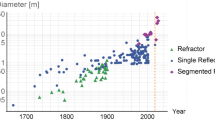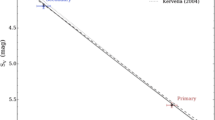
Overview
- Presents a variety of easy yet fascinating projects to observe and measure celestial phenomena
- Offers step-by-step instructions for replicating pivotal discoveries in the history of astronomy
- Translates various physical laws that govern astronomy into observational plans that can be followed with a garden-variety telescope
Part of the book series: Springer Praxis Books (PRAXIS)
Part of the book sub series: Popular Astronomy (POPULAR)
Access this book
Tax calculation will be finalised at checkout
Other ways to access
About this book
You too can follow in the steps of the great astronomers such as Hipparchus, Galileo, Kepler and Hubble, who all contributed so much to our modern understanding of the cosmos. This book gives the student or
amateur astronomer the following tools to replicate some of these seminal observations from their own homes:
With your own eyes: Use your own observations and measurements to discover and confirm the phenomena of the seasons, the analemma and the equation of time, the logic behind celestial coordinates, and even the precession of the equinoxes.
With a consumer-grade digital camera: Record the changing brightness of an eclipsing binary star and show that a pulsating star changes color as it brightens and dims. Add an inexpensive diffraction grating to your camera and see the variety of spectral features in the stars, and demonstrate that the Sun’s spectrum is similar to one particular type of stellar spectrum.
With a backyard telescope: Add a CCD imager and you can measure the scale of the Solar System and the distance to a nearby star. You could even measure the distance to another galaxy and observe the cosmological redshift of the expanding universe.
Astronomical Discoveries You Can Make, Too! doesn’t just tell you about the development of astronomy; it shows you how to discover for yourself the essential features of the universe.
Similar content being viewed by others
Table of contents (5 chapters)
-
Front Matter
-
Back Matter
Reviews
“This is one of the most genuinely exciting new astronomy books I’ve seen in a long time. It shows you, for example, how you can use Galileo’s method to work out the height of mountains on the moon. … The time commitment and equipment requirements for each project are well set out, and the projects are well explained. … this book a treat for the armchair astronomer, but a real treasure trove for a team of committed explorers.” (Andy Sawers, Astronomy Now, February, 2016)
Authors and Affiliations
About the author
About the Author
Once upon a time, back in the days when the roar of Rocketdyne’s rocket-engine tests in the Santa Susanna mountains would roll through the San Fernando Valley like an earthquake, there was a small gang of fourth-graders who discovered that astronomy was a parent-approved reason to stay out in the backyard all night. We had an Edmund Scientific 3-inch reflector and a 2.5-inch Sears refractor. With them, we discovered the craters on the Moon, the rings of Saturn, and the moons of Jupiter, and we dreamed of a life spent studying the universe. I don’t remember ever seeing a galaxy or nebula, but I have vivid memories of watching the Perseid meteor shower, and less-vivid memories of the members of the gang helping each other to learn how to solve algebra problems.
Time passed, we dispersed to our various careers, and the stars themselves faded in the suburban sky. Then one Christmas, my wife decided that I might enjoy a telescope. That wonderful 6-inch Newtonian was a portal to new worlds: the beauty and mystery of the night sky, the community of the Orange County Astronomers, the craftsmen at the Riverside Telescope Makers Conference, larger telescopes (for deeper deep-sky observing), smaller telescopes (for asteroid occultations), CCD photometry, the Society for Astronomical Sciences, and a backyard observatory. I’ve been privileged to meet remarkable people (some famous, others unsung), see things that most people never witness, and learn about a wide range of phenomena, personalities, and possibilities. I hope that along the way – as Secretary of the Orange County Astronomers, a Board member of the Society for Astronomical Sciences, as a speaker, writer and mentor – I have been able to help other people expand their horizons as well. I wrote The Sky Is Your Laboratory as a way of helping other amateur astronomers try their hands at small-telescope research. The present book will, I hope, give amateur astronomers, students, and instructors a new way to learn about the beauty of the heavens and experience the history of astronomical discovery.
Bob Buchheim
December, 2014
Coto de Caza, CA
Accessibility Information
Bibliographic Information
Book Title: Astronomical Discoveries You Can Make, Too!
Book Subtitle: Replicating the Work of the Great Observers
Authors: Robert K. Buchheim
Series Title: Springer Praxis Books
DOI: https://doi.org/10.1007/978-3-319-15660-6
Publisher: Springer Cham
eBook Packages: Physics and Astronomy, Physics and Astronomy (R0)
Copyright Information: Springer International Publishing Switzerland 2015
Softcover ISBN: 978-3-319-15659-0Published: 28 May 2015
eBook ISBN: 978-3-319-15660-6Published: 12 May 2015
Series ISSN: 2945-7475
Series E-ISSN: 2945-7483
Edition Number: 1
Number of Pages: XIII, 549
Number of Illustrations: 46 b/w illustrations, 122 illustrations in colour
Topics: Popular Science in Astronomy, Astronomy, Observations and Techniques, History of Science



